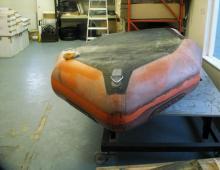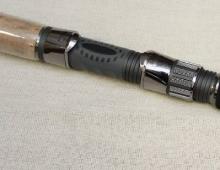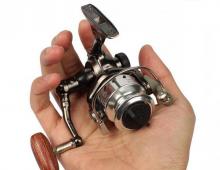Choosing a feeder rod for beginners
Feeder is a modern and improved donka. A beginner, in such an interesting activity as fishing, may not immediately understand what is the innovation and the difference between a donkey and a feeder.
But fishermen with many years of experience have already appreciated the dignity of feeder fishing.
Feeder rod
The length of the feeder rod ranges from 2.5 m to 5 m. The most common are rods with a length of 3.5 m to 4 m. If you are fishing in a pond with still water, then a length of up to 3.5 m will be enough .
On a large river with an average current, a feeder length of 3.5 m to 4 m is used. On an intense current and distant casts, more than 80 m, a 5 m rod is used.
Feeder Rod Materials
The feeder rod is made from:
- fiberglass– a strong rod for fishing in intense currents using weighted feeders, planning ultra-long casts and catching big fish.
- CFRP- a light rod, born for fishing in still water or in a weak current, is characterized by increased sensitivity.
- Composite- the best choice for a beginner, it is affordable, durable, comfortable.
Separation of feeder rods by class
The rod itself, as in the donk, in addition to the length, differs in action and test.
Action - the ability of a rod to bend. The rod, according to the system, is divided into three types:
- slow action– the rod bends into an arc along the entire length of the feeder, starting from the handle.
- Medium action– the rod has reduced flexibility and starts to bend approximately from the middle.
- Quick action- a strong rod in which only the end bends.
In addition, the rod is classified according to the maximum weight of the load and the casting distance. That is, with the help of a heavy rod and weight, weighing 120 grams, you can cast up to approximately 100 m.
This rod is relevant for large and deep waters. For a casting distance of up to 50 m, a rod of medium flexibility with a load of 50 to 90 grams will be enough for you.
Perfect for fishing in small rivers, ponds, where the current is less intense. With a slow action rod and a load of up to 40 g, you should not go further than shallow water bodies. Casting less than 30 m.
Like rods, tips have their own classification. They are divided by sensitivity. The thinnest tips bend, even if a slight breeze blows.
Feeder tops are classified into:
- Rigid- practice when fishing with a strong current.
- medium hardness- practice when fishing with a moderate current or with a strong wind.
- Soft- they are used in reservoirs with stagnant water or with a very weak current, they bend even with a light breeze.
From this we conclude that before going fishing with feeder gear, you need to know the specifics of the reservoir or have different feeder gear.
Feeder reel
Let's move on to coil selection. Let's say right away that you should not take a cheap one, since bottom fishing involves fighting underwater snags, algae, and this is in addition to fighting the fish itself.
A relatively high-quality and inexpensive coil costs from $60 and up. There are coils on sale for $ 500, but this is already a waste of money.
Make an average choice in favor of a well-known manufacturer, and in the future you will figure out for yourself whether you need a more expensive model or not.
feeder equipment
Feeder tackle can be used as an ordinary fishing line, and as a braided line. For fishing in small reservoirs, an ordinary fishing line with a diameter of 0.2 to 0.25 mm will suffice.
You can’t save on fishing line for leashes. Therefore, take the best and highest quality that you can afford.
The length depends on the conditions of fishing, but on average, leashes are set no more than 50 cm long in a quiet pond, and from 50 to 100 cm in a pond with a strong current.
Hooks for feeder
Hooks are chosen for bait, not for fish. Numbers from 10 to 15 according to the international classification of hooks are most suitable for feeder fishing.
Remember a small rule - with a weak bite, your equipment should be invisible. Set the leash thinner, the smallest hooks, and vice versa, with a good bite, put bigger hooks and a good, powerful leash.
The hook should be sharp, easily pierce the maggot or other bait. On thinner hooks, the bait stays alive longer than it attracts fish, but there is a greater chance of fish coming off.
The thicker hooks hook the fish tightly and the probability of the fish coming off is small. Some of the most popular hooks for catching fish are hooks from such brands as: Gamakatsu, Kamasan, Hayabuca.
Feeders for feeder
The feeder for the feeder is one of the main design elements of the rod. One of the main requirements is aerodynamic characteristics.
When casting 50 meters or more, no other methods of bait delivery are effective. When choosing a feeder feeder, consider the conditions of fishing.
In one case, it is necessary that the bait quickly disperses in the water, in other cases it is a long and stable trail that will dissolve in the fishing area for a long time.
Probably, you should not say that the feeder should be strong and durable.
Also, it must be securely fixed at the bottom and be resistant to flow, that is, not to move.
"Cages" are considered ideal feeder feeders. These are either round, or triangular, or rectangular, mesh, no more than 5-10 cm long feeders.
Rectangular or square ones are used in strong currents, as they “hold the bottom” well, and round ones in weak currents. Each feeder has a weighting agent in the form of a lead plate.
Feeders are classified into:
- open- Fishing in still water or with a weak current. The mixture is released quickly.
- semi-closed- fishing in the middle course, the mixture, slowly releasing, forms a stern plume.
- Closed- for bait of animal origin (maggot, bloodworm), if necessary, it can also be used as an open-type feeder by removing the end caps.
Round or oval feeders have excellent aerodynamic properties. In them, the fishing line passes through the central rod and it is equipped with stoppers.
This ensures a smooth ride on the line and reduces the possibility of line breakage.
Lure
The better the fishing spot is fed, the more effective fishing will be. In bottom fishing, we try to catch fish that move in packs and move around the water in search of food without any logic.
And we just need to lure her to the right place. When flowing, you need to use bait with a strong smell. This will force the fish to come closer to the food source.
And in stagnant water, it is better to use a slowly soluble bait with a large fraction. Food for fish will be in one place and the fish will not leave the place of fishing.
How to catch more fish?
I have been active fishing for quite some time and have found many ways to improve the bite. And here are the most effective ones:- . Attracts fish in cold and warm water with the help of pheromones included in the composition and stimulates their appetite. It's a pity that Rosprirodnadzor wants to ban its sale.
- More sensitive gear. About reviews and instructions for other types of gear you can find on the pages of my site.
- Lures using pheromones.
Do not overdo it with the brightness of the bait. Some fishermen believe that a bright spot at the bottom of a pond will attract fish. This is not true, on the contrary, if the bait is clearly different from the bottom of the reservoir, this will scare away the fish.
Try to choose bait by color, approximately similar to the bottom of the reservoir.
The basis of bait includes a nutritious part like cookies, crackers, crushed cereals. The stern part is added to them - this is boiled corn, peas, pearl barley, chopped maggots, worms, compound feed.
Well, you need to “glue” it all tightly - semolina, flour, sticky porridge. Some anglers add various flavors, dyes, and even geyser-forming concentrates.
The main thing is that the bait should reach the bottom intact, in the feeder trough. If the bait is prepared correctly, then bites will follow every 5 to 7 minutes.
If there is no bite for more than 15 minutes, then we continue to feed the fish with new portions. Each fisherman has his own feeding recipe developed over the years.
It is easier for a beginner to go to the store and buy ready-made bait, the main thing is that it has a strongly pronounced smell.
Feeder fishing
Well, it seems that we figured out the tackle, we chose the reservoir, prepared the bait, there was a little left to catch a fish. We start with the bait of fish, the so-called starter feed. 
From 10 to 20 casts in the same place, with a moderately full feeder. Try to make the first casts accurately, without deviations.
The time interval between casts is up to 10 minutes.
That is, you made the first cast, tried on whether it went well, made any adjustments for yourself.
If there is no bite, then at the moment there is no fish in the fishing area.
You need a bait with a strong smell to lure the fish. After the first cast, make sure the feeder is empty and if it is not, change the bait.
How to achieve accurate throws in the same place? Choose a landmark, as a rule, this is a tree standing on the other side or a snag sticking out of the water, but in general, anything.
You can try to fix the line on the reel after the first cast, thereby fixing the length of the unwind. But here you need to be extremely careful, as a stronger cast will break the line, and the tackle will go under water.
How to hook up with a feeder? When biting, do not grab the rod and pull it as if your life depended on it.
Make sure that the bite is expressive, calmly take the feeder in your hand and gently pull back until you feel a hooked fish. Sharp hooks lead to the loss of fish, and even worse, to the loss of gear.
Clearly visible bites - this is when the tip of the rod clearly bends, or sharply bent, completely unbends and slack forms on the fishing line. In these cases, feel free to cut.
And it happens that the tip twitches finely and in this case it is difficult to determine whether it is worth hooking or not. As a rule, with a slight twitch of the tip, the fish approached and touched the line or feeder.
Please note that if you have all the signs of a bite, and when you pull out the tackle there is no one on the hook, this means that there are a lot of small fish in the fishing area.
In this case, change to a larger tackle or continue fishing, but increase the number of casts. By doing this, you will either "overfeed" a trifle or attract larger fish.
Another point, if, having pulled out the tackle, you saw a battered bait on the hook, but the tip did not show itself in any way, then it is worth reducing the length of the leash by almost half.
The simplest equipment for the feeder
An anti-twist with a feeder is put on the main line, then a stopper is put on, its purpose is to prevent the knot that connects the main line and the swivel from breaking.
A leash with a hook is attached to the swivel. There is a slightly more difficult option. The top swivel is attached to the main line. A thick monofilament is attached to the upper swivel, with two stoppers at the edges.
In the middle of the monofilament there is an anti-twist with a feeder. After the lower stopper, the lower swivel is attached, to which a leash with a hook is attached with a “dead loop”.
The difference is that the anti-twist with the feeder are freely located on a half-meter segment of a rigid monofilament.
Paternoster (Gardner rig)
The simplest feeder equipment. This equipment does not use swivels, stoppers, anti-twisters. The main fishing line is taken and a loop is made on it for attaching the leash.
From the loop we measure approximately 20 - 25 cm and make another loop more. The feeder should fit into the large loop.
Attaching a feeder to a large loop, first passing the loop through the eye, and then throwing it over the feeder. We attach the leash to the small loop with a “surgical loop”. The tackle is ready. The disadvantage of this gear is that the main line is twisted.
asymmetrical loop
We fold the rigid fishing line in half and retreat 10 cm from one edge. We thread the feeder and tie it with a double or triple knot. We got a loop with 10 cm ends and a free-hanging feeder, with a total length of approximately 60 - 70 cm.
Now we make a loop to connect to the leash. Separately, we make a twist from fishing line, 15–20 cm long and with a knot at the end. We fasten the twist to an asymmetrical loop at a distance of 40 to 70 cm from the main fishing line. We attach a leash with a hook to the twist.
With such knitting gear, the feeder is at the bottom of the loop. The bait hook is located approximately at the level of the feeder.
The fish, having swallowed the hook, drags it to the side, but the feeder, sliding along the loop, does not give the fisherman a false bite. And only when the feeder rests on the loop, the bite signaling occurs.
The difference between the Gardner rig and the asymmetrical loop is that in the first case, bites occur, and in the second it is a bite.
Symmetric loop
The most common type of knitting tackle. Used in 80 - 100% knitting tackle. This type of mating is good, both in flow and in still water. Take about 1 meter of strong, thick fishing line.
Fold the fishing line in half and make a loop at one end, we will hook the leash with a hook on it. The loop must be strong. Use a triple or even quintuple knot.
Then we intertwine two fishing lines with each other by about 20 cm and also fix with a five-knot. This is what we got as an anti-twist.
After that, on any of the free ends, we put on the feeder, and we tie the ends with a strong, powerful knot, since during the cast the main load will fall on it. The loop is ready. It is attached to the main line with a “surgical loop”.
Feeder fishing belongs to sports disciplines, as it involves the ability to analyze the situation and make correct adjustments in connection with constantly changing circumstances.
Frequent and accurate recasting of gear, improving bait, making rigs, responding to bites, all this makes feeder fishing a great pastime, and a rich catch will be your reward for all the hardships associated with it.
Now only I bite!
I caught this pike with a bite activator. No more fishing without a catch and looking for excuses for your bad luck! It's time to change everything!!! The best bite activator of the year! Made in Italy...



